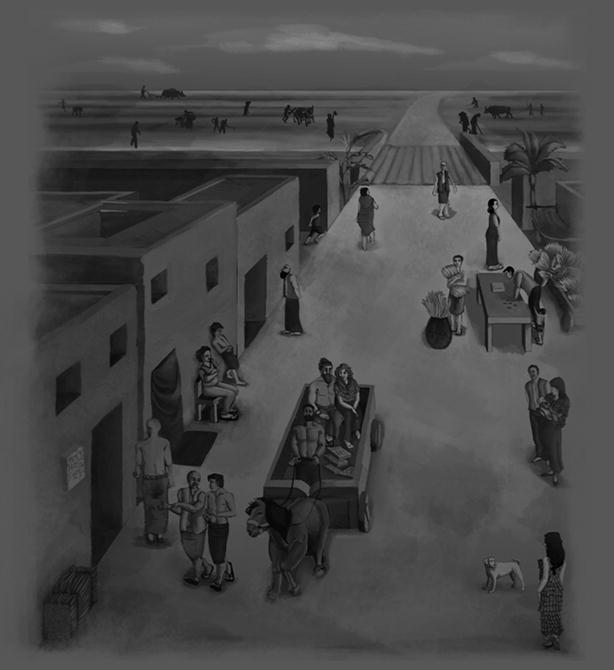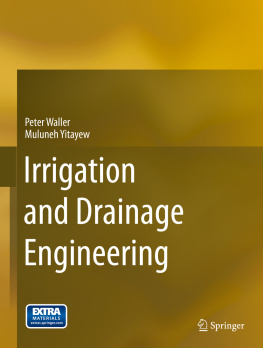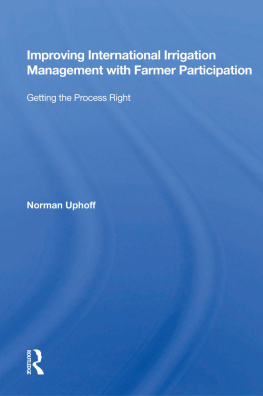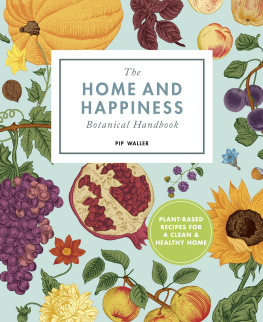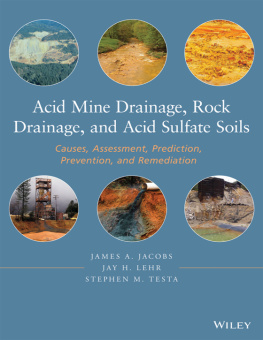Irrigation engineering is the analysis and design of systems that optimally supply the right amount of water to the soil at the right time to meet the needs of the plant system. The enterprise may be growing plants for food, landscape irrigation, or other purposes. Subsurface drainage engineering is the analysis and design of systems that remove water or salts from the soil in order to maintain as close to an optimal plant growth environment as possible.
System design and selection involves three steps. The first step is to characterize crop water requirements, hydrology, and soil characteristics. The second step is the hydraulic design of potential alternatives. The third step is an economic and environmental analysis. To adequately evaluate alternatives, it is important to look at all relevant inputs to the system (water, energy, labor) and at the effect of the system on the environment. Two consistent themes in this book are engineering economic analysis and assessment of environmental impact. Engineering economic analysis sums capital and annual costs in order to calculate the total present value cost of the system. Environmental assessment includes the estimation of such effects as chemical leaching, chemical runoff, soil erosion, and water resource depletion.
Design of irrigation and subsurface drainage systems involves the application of engineering, biology, and soil science in both synthesis and analysis methods of problem solving to assemble components that will fit together for a specific location and crop production system. Thus, aside from the knowledge of hydraulics and other engineering concepts, irrigation and drainage engineering require an understanding of the soil and water environment, soil-water-plant relationships, and hydrology. The feasibility of irrigation and subsurface drainage systems must also be examined from the social point of view. This is particularly true in developing countries where irrigation and drainage projects are undertaken to change the livelihood of the local communities and the region at large.
This book covers irrigation and subsurface drainage fundamentals, systems, and impacts. Chapters ). One of the strengths of this book is that almost all of the chapters have associated VBA/Excel programs. The programs enable students to evaluate realistic scenarios in homework problems and to more readily translate the knowledge and techniques in this book to the real world.
History of Irrigation and Subsurface Drainage
Irrigation and civilization have gone hand in hand. Beginning 8000 years ago, the Ubaid and then the Sumerians in Ancient Mesopotamia invented civilization and intensive irrigated agriculture at the same time. Regional canals delivered water from the Tigris and Euphrates rivers to large-scale irrigation systems and farms. Cities had between 50,000 and 80,000 people, with almost 90 % of the people living in the cities. Almost half of the population worked on the large irrigated farms (Fig. ) surrounding each city. With modern agricultural methods, only 1 % of the population can now feed the rest of the population.
Fig. 1.1
Sumerian city with canal and surrounding farms (Credit Mariah Dunn, University of Arizona)
The importance of regional canals in Mesopotamia is evident in a statement by the famous Babylonian king Hammurabi (1750 BC):
When Anu and Bel (gods) gave me the land of Sumer and Akkad to rule, I dug out the Hammurabi-canal named Nuhus-nisi. Both the banks thereof I changed to fields for cultivation, and I garnered piles of grain, and I procured unfailing water for the land. As for the land of Sumer and Akkad, I collected the scattered peoples thereof, and I procured food and drink for them. In abundance and plenty I pastured them, and I caused them to dwell in peaceful habitation.
Not only were the canal systems remarkable, but the management of irrigation at the farm scale was also technologically advanced, as described in the following selected excerpts from the Sumerian Farmers Almanac (1700 BC, translated from cuneiform by Samuel Kramer):
In days of yore a farmer instructed his son: When you are about to take hold of your field (for cultivation), keep a sharp eye on the opening of the dikes, ditches, and mounds, (so that), when you flood the field the water will not rise too high in it. When you have emptied it of water, watch the field's water-soaked ground that it stay virile ground for you plow diagonal furrows where you have plowed straight furrows, (And) Plow straight furrows where you have plowed diagonal furrows. Let your straight furrows make your borders into tulu -borders; let the lu -furrows make straight your borders. Plow ab -furrows where. (Then) Let all its clods be removed; all its high spots be made into furrows; (and) all its depressions be made into low furrows When the barley has filled the narrow bottom of the furrow, water the top seed. When the barley stands up high as (the straw of) a mat in the middle of a boat, water it (a second time). Water (a third time)-its royal barley. If the watered barley has turned red, what you say is: "It is sick with the samana -disease." But if it has succeeded in producing kernel-rich barley, water it (a fourth time); (and) It will yield you an extra measure of barley in every ten (+10 %)
We can see the importance that the Sumerians placed on straight furrows, proper maintenance of dikes and ditches, leveling, borders and basins, crop monitoring, and irrigation scheduling. Nothing has changed. Irrigation engineers and managers must still pay careful attention to the design and maintenance of their irrigation systems. Farmers must manage water effectively. As stated in the Almanac , yield might be increased by 10 % with optimal irrigation management.
The Sumerian culture vanished from Sumer in 2350 BC. This took place at the same time that the soil became salinized. The Sumerians returned to Sumer in 2055 (short chronology) and formed the Third Dynasty of Ur for approximately 100 years. Evidence of the salinization is found in cuneiform agricultural records, which report that grain yields in 2400 BC were 2347 L/ha, but production dropped to 1460 L/ha in 2100 BC. Yields then dropped even further to 900 L/ha in 1700 BC. Another indication of salinization is that 80 % of the grain percentage was barley in 2400 BC, but it rose to 99 % barley in 2050 BC. Barley is a salt tolerant crop and is often the first crop used to reclaim saline desert soils for agriculture. A higher percentage of barley in the crop mix indicates soil salinization.
The Egyptians learned about intensive agriculture from the Sumerians. Their irrigation was dependent on the annual flooding of the Nile, which had a different and more predictable annual flood pattern than the Tigris and Euphrates. The water in the Nile covered the Nile floodplain with 1.5 m of water in September and remained for approximately 1 month. Once the fields were dry in November, the farmers planted a winter wheat crop and then harvested the crop in April and May. If necessary, they built basins to impound the water until fields were fully saturated and then allowed the water to drain away. Because the water table was 34 m below the ground surface just before the floods, the floodwaters pushed the salts out of the root zone each year.
